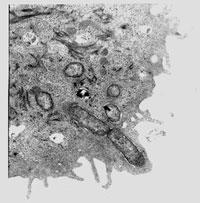Chloroplasts, professor of genetics
2001/04/26 Roa Zubia, Guillermo - Elhuyar Zientzia
When life was created there were many monocellular organisms. One of them ingested bacteria capable of photosynthesis and became the first plant cell. As the evolution of life progresses, there have been many such processes (which continue to occur). As a result, genetic changes occur. The organism internalizes and puts into the nucleus the genes of the ingested bacteria. The bacterial nucleus dissolves, but its genes advance. Organisms thus formed are called nucleoforms.
Vestiges of this type of process in the ancient evolution are exposed in the genome of theta nucleomorfa Guillardia, recently decoded by UK researchers. This organism performs photosynthesis, so it can be considered a simple chloroplast. Next to the man has a very small genome, with 531 genes exclusively and 6,000 times less.
There are not many transformations in this genome. And it has many genes, because of their size, the genes hardly have gaps (introns) without information and are repeated very little. It is a compact genome. Evolution has caused the destruction of superfluous genes. In fact, only those essential for chloroplasts remain in the metabolism area.
The authors have learned a lot from this genome. Experts compare the human genome to appreciate the importance of this small genome. In humans the Y chromosome is preserved because it contains mandatory information. Likewise, practically all of the nucleomorphic genome is essential for survival. This organism cannot be closer to the basic eukaryotes. Therefore, it is the perfect starting point for analyzing the evolution of others.

Gai honi buruzko eduki gehiago
Elhuyarrek garatutako teknologia





